EXERCISES
FOR
SCIATICA
EXERCISES
FOR
SCIATICA
A Simple and Effective
Self-Care Program for Pain Relief
and the Treatment of Sciatica
WILLIAM SMITH, MS, CSCS, MEPD
WAZIM BUKSH, MD, MPH


Hatherleigh Press is committed to preserving and protecting the natural resources of the earth. Environmentally responsible and sustainable practices are embraced within the companys mission statement.
Visit us at www.hatherleighpress.com and register online for free offers, discounts, special events, and more.
Exercises for Sciatica
Text copyright 2020 William Smith and Wazim Buksh, MD, MPH
Library of Congress Cataloging-in-Publication Data is available upon request.
ISBN: 978-1-57826-789-7
All rights reserved. No part of this book may be reproduced, stored in a retrieval system, or transmitted, in any form or by any means, electronic or otherwise, without written permission from the publisher.
Cover and Interior Design by Courtney Wade
Printed in the United States
10 9 8 7 6 5 4 3 2 1
 Your health starts here! Workouts, nutrition, motivation, community everything you need to build a better body from the inside out!
Your health starts here! Workouts, nutrition, motivation, community everything you need to build a better body from the inside out!
Visit us at www.getfitnow.com for videos, workouts, nutrition, recipes, community tips, and more!
Consult your physician before beginning any exercise program. The author and publisher of this book and workout disclaim any liability, personal or professional, resulting from the misapplication of any of the following procedures described in this publication.
CONTENTS

A New Approach to Sciatica Wellness
H eres a fun fact for you: the Centers for Disease Control (CDC) reports that Americans are sitting an average of 13 hours a day and sleeping an average of 8 hours, resulting in a sedentary lifestyle of around 21 hours a day.
The average American spends nearly half their day staring at a screen. A new audience report put out by the Nielsen Company reveals that adults in the United States devoted about 10 hours and 39 minutes each day to consuming media during the first quarter of 2019. This figure includes the time we spend each and every dayusing our tablets, smartphones, personal computers, televisions, and multimedia devices.
Is it any surprise that back pain symptoms are on the rise?
Of course, its not all our own faults. Every day, we face lifes unrelenting grindthe rigors of commuting to work, only to be figuratively chained to our desks for hours on end. For those eight hours (or more) we become habitual sitters, as the same technology that has revolutionized the world creates a society of stagnation.
This lack of daily movement has led to rampant obesity, and a society full of individuals who have developed muscular imbalances and flexibility issues to their unhealthy lifestyle. Each day, they are made to deal with the ultimate consequence of these issues: chronic low back pain.
And its not as though we can just take it easy and things will mend on their own. With every step we take, we subject our bodies to physical force that travels up from our feet and leads up to our spine, where various neural structures (our bodys electrical wiring) are housedincluding the sciatic nerve, a large nerve that connects from the lower half of our spine to our lower legs. In combination with the imbalances caused by our sedentary lifestyles, the ground reaction forces from a single step transferred up this chain converge, placing pressure on our wiring and creating new and worsening pain.
Chronic low back pain and sciatica affect millions of Americans each year, with severity ranging from simply nagging to truly debilitating. Often multifactorial in nature, the pain can permeate to all aspects of an individuals life, leading to functional disability and crippling mental distress.
Fortunately, theres a fix. By incorporating more physical activity into your daily routine (even if it doesnt completely meet the recent government recommendations of 150 minutes of moderate to vigorous exercise a week), you can help offset some of the negative health effects of sitting for long periods of time.
Exercises for Sciatica was designed to provide a complete workout program and lifestyle guide for those suffering from low back pain and sciatica. Taking as its two primary focuses strengthening muscles and relieving pain, it addresses sciatic pain from a broad spectrum, bio-psycho-social perspective. Weve chosen to tackle this pain by examining how it is influenced by physical strain and exacerbated by negative mental and emotional states, such as depression. In so doing, we provide a pragmatic approach to identifying causative elements and personal risk factors, and finding tangible solutions for symptom relief.
More than anything, sciatica is a condition brought about by an unhealthy lifestyle. Rather than resort to expensive, potentially addictive painkillers and prescription medication, we can choose to view this as a wake-up call to become more active and live a healthier, happier life.
Our goal is to empower you not only to identify the negative health factors in your routine but to find reliable, cost-effective strategies to both reverse symptoms and prevent future instances of sciatic pain. To that end, weve created an exercise program which has little to no cost, much of which requires no equipment beyond your own body. Using the same multidisciplinary approach employed by personal trainers, we then move beyond symptom relief and progress to true rehabilitation, restoring you to a functional state of well-being.
In this book, you will find information about the common causes of sciatica and its side effects, along with practical tips for managing symptoms and improving your quality of life. You will also find a complete exercise list and workout program, tailored to help strengthen those muscles which support the spine and increase circulation to the discs of the spine to relieve pressure on the sciatic nerve and reduce pain. These, along with other benefits, are all reasons why it is so important to in-clude an exercise program as part of your complete approach to treating sciatica.
Sciatic pain is a state of aggravation and irritation that penetrates every aspect of wellness. While not all cases of sciatica are preventable, the simplest and most common-sense healthy lifestyle choices can greatly reduce your chances of developing it, keeping you active and pain-free. Together, lets resolve to learn how best to respond to this pain, rather than react to it.

CHAPTER 1
Defining Sciatica
B ack pain is one of the most common reasons that people go to see their doctors. Whether it is acute pain that develops suddenly or chronic pain that lingers for months, adults will often report having at least one day of back pain roughly every three months. Back painspecifically pain related to the sciatic nerve, a long nerve pathway which runs from your lower back, through your hips and buttocks and down each legcan seriously hamper mobility, disrupt sleep, and even take a psychological toll on someone during the days, weeks, or even months that their pain persists.

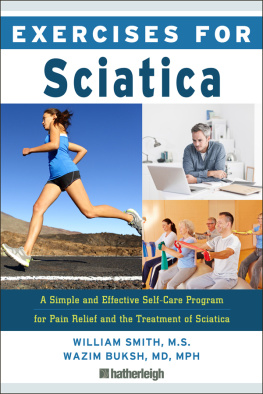






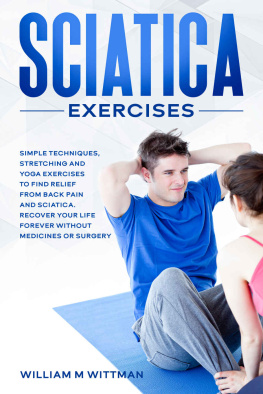
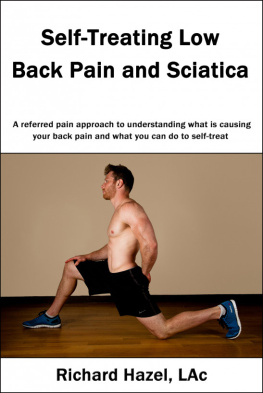

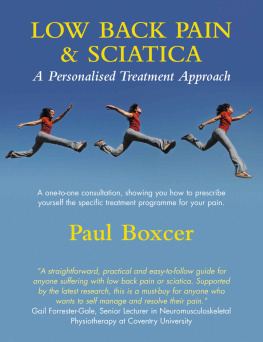

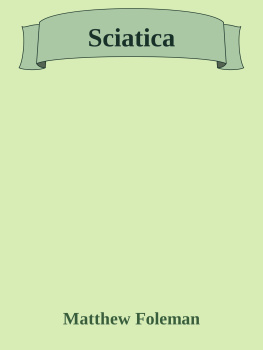


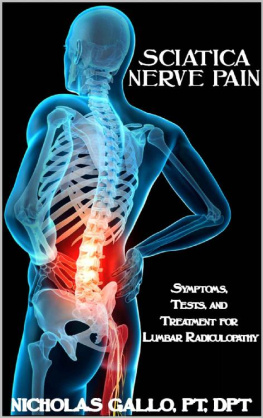
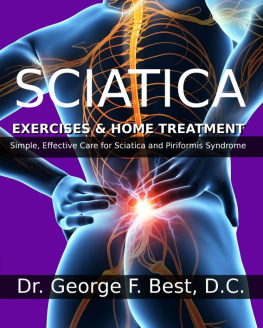



 Your health starts here! Workouts, nutrition, motivation, community everything you need to build a better body from the inside out!
Your health starts here! Workouts, nutrition, motivation, community everything you need to build a better body from the inside out!
